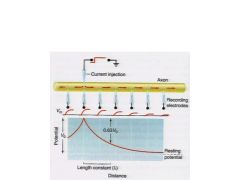![]()
![]()
![]()
Use LEFT and RIGHT arrow keys to navigate between flashcards;
Use UP and DOWN arrow keys to flip the card;
H to show hint;
A reads text to speech;
19 Cards in this Set
- Front
- Back
|
If the cell membrane what part of a circuit, it would function as a:
A ion channel functions as a: |
Membrane functions as a Capacitor
Channel = resistor |
|
|
Since the multisubunit ion channels allow ions to flow through, it is:
Ion flow through these channels is dependent on these two factors: |
Aqueous. Dependent on size and charge
|
|
|
Bc ion channels can be opened or closed, they function as a: (i.e what is the anologue to a circuit?)
|
Variable resistor
|
|
|
What is meant by a channel that is minimally selective? Highly selective?
|
Minimal will allow only cations or anions through.
Highly will specify if a Na or K is allowed through |
|
|
What are the four factors that can determine whether a gate is opened or closed?
|
1. Voltage
2. Ligand (glutaminergic) 3. Thermal 4. Mechanical |
|
|
Imagine a beaker of water separated with a semipermeable membrane. On one side, you have a solution of salt and water will flow into the salt solution. What is the term used to describe the pressure moving into the salt solution. What about the water from the solution flowing back?
|
Osmotic Pressure (to sln)
Hydrostatic Pressure (out of sln) |
|
|
What are the two factors that influence net passive diffusion?
|
1. Electrochemical gradient
2. Conductance of the channel |
|
|
Describe the forces involved in the Electrochemical gradient (2):
|
1. Chemical gradient
2. Difference in electrical potential |
|
|
The membrane has leaky channels that let K and Na ion through (K more easily than Na). If this goes on, sooner or later, the potential will go from -65mV to 0mV. However, this does not happen. What maintains the potential?
|
The Na/K ATPase pump
|
|
|
If a potential goes from -65mV to -20mV it is called:
If a potential goes from -65mV to -90mV, it is called: |
1. Depolarization
2. Hyperpolarization |
|
|
What is the Length Constant and how is it calculated? What is it dependent on?
|

It describes distance over which the potential falls by 63% from its original value. Dependent on the Rm (resistance of the membrane) and the RI (longitudinal resistance)
|
|
|
What is meant by "Absolute Refractory Period"?
|
The period in which there is absolutely no chance that an action potential can be induced.
|
|
|
What is meant by "Relative Refractory Period"
|
You can generate an action potential but it will never be the maximum.
|
|
|
Why are refractory periods important?
|
They limit the repetition rate of APs
|
|
|
Voltage-gated Na channels have 3 states: Resting, Open, and Inactivated. What is the inactive state? What does phenomenon drive?
|
When the channel is closed and n mater what happens with respect to the membrane potential, it will not open/change. This is the driving force behind the refractory period.
|
|
|
Which channel opens faster: Na or K?
|
Na
|
|
|
Is there an inactive state for K channels?>
|
No.
|
|
|
What cause the after-hyperpolarization in an action potential?
|
K and its slower falling phase of conductance.
|
|
|
How is the refractory period essential for propagating signal in one direction?
|
Because the adjacent Na channel causing the AP cannot open the Na channel previous to it bc it is in its inactive refractory period. The only channel that it can activate is the one in front of it.
|

